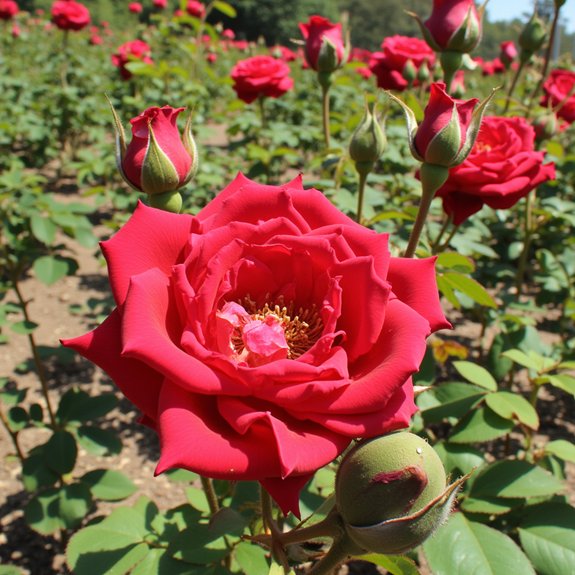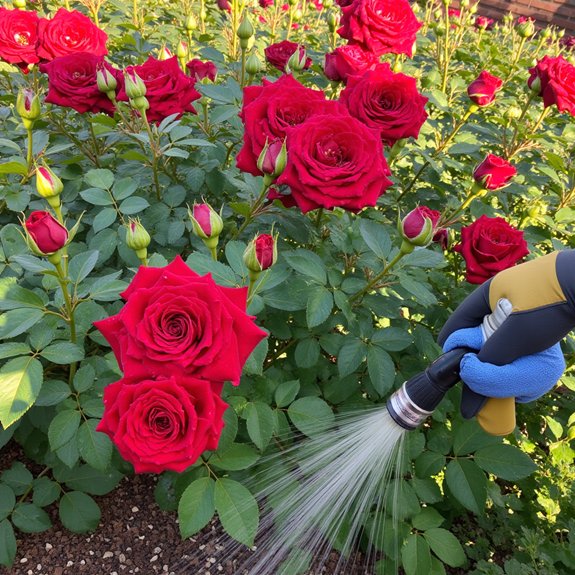Heat-tolerant roses solve a common gardening dilemma that plagues sunny landscapes. Many gardeners assume roses wilt under intense summer sun, but certain varieties actually thrive in temperatures exceeding 90°F. These resilient cultivars, including ‘Knockout’ and ‘Desert Peace,’ maintain their blooms while others fade. The secret lies in selecting roses bred specifically for harsh conditions, understanding their water requirements, and timing planting correctly. However, choosing the right variety requires knowing which characteristics truly matter.
Contents
- 1 Understanding Heat Stress in Rose Gardens
- 2 Top Heat-Tolerant Rose Varieties for Hot Climates
- 3 Essential Care Techniques for Summer Rose Maintenance
- 4 Choosing Roses by Hardiness Zones and Sun Requirements
- 5 Disease-Resistant Varieties for Low-Maintenance Gardens
- 6 Fragrance and Color Options in Heat-Tolerant Roses
- 7 Growth Habits and Support Requirements for Different Rose Types
- 8 Companion Planting and Garden Design With Heat-Resistant Roses
Understanding Heat Stress in Rose Gardens

When temperatures climb above 85°F, even the most robust roses begin to show signs of distress that can puzzle gardeners. Heat stress manifests through several telltale rose symptoms including leaf scorch, wilting, and sudden leaf drop. Blooms become noticeably smaller as plants conserve precious energy for survival. The most dramatic response occurs when roses enter heat-induced dormancy, fundamentally shutting down growth just like winter dormancy. This protective mechanism helps plants survive extreme conditions. Gardeners often mistake these symptoms for disease or watering issues, but recognizing heat stress patterns helps determine appropriate care adjustments during scorching summer months.
Top Heat-Tolerant Rose Varieties for Hot Climates
While heat stress challenges most roses, certain varieties thrive in scorching conditions that would devastate traditional garden roses. ‘Yolande d’Aragon’ produces fragrant purple-pink blooms in zones 4-9, offering reliable seasonal blooms even during summer’s peak. ‘Mardi Gras’ displays vibrant yellow, apricot, and red flowers, creating stunning rose combinations with cooler-toned varieties. ‘Dark Lady’ delivers deep crimson blooms with classic old rose fragrance, while ‘Easy Does It’ features peach-pink scalloped petals. For full-sun locations, ‘Blue for You’ provides unique purplish-pink flowers with white centers. These heat-resistant champions maintain their beauty when temperatures soar above 85°F.
Essential Care Techniques for Summer Rose Maintenance

Even heat-tolerant rose varieties require strategic summer care to maintain peak performance during extreme temperatures. Monitoring soil moisture becomes critical, as roses need consistent hydration without waterlogged conditions. Check soil depth of 2-3 inches daily during peak summer months. Apply 3-4 inches of organic mulch around the base, keeping it away from stems to prevent rot. Summer pruning focuses on removing spent blooms and damaged foliage rather than major structural cuts. Deadhead flowers by cutting just above the first five-leaflet leaf. Water deeply at soil level during early morning hours to minimize evaporation and prevent leaf diseases.
Choosing Roses by Hardiness Zones and Sun Requirements
Understanding hardiness zones and sunlight needs helps gardeners select roses that will thrive rather than merely survive in their specific climate. Zone 4-9 varieties like Yolande d’Aragon offer the widest geographic appeal, while zone 6-10 options such as Peter Pan suit milder regions. Most heat-resistant roses tolerate full sun to partial shade, providing flexibility in garden placement. Rose selection strategies should prioritize matching zone requirements to local winter lows, ensuring long-term survival. Seasonal planting tips include spring installation in colder zones, fall planting in warmer areas. Consider sunlight patterns throughout your garden before committing to specific locations.
Disease-Resistant Varieties for Low-Maintenance Gardens

Beyond matching roses to climate conditions, gardeners benefit from selecting varieties that naturally resist common diseases, reducing the time and effort required for maintenance. Disease-resistant roses like ‘Dark Lady’ and ‘Easy Does It’ combat black spot, powdery mildew, and rust without chemical interventions. These robust varieties maintain healthy foliage throughout growing seasons, contributing to overall plant vigor and consistent blooming.
Effective disease prevention strategies include choosing roses with proven resistance ratings and ensuring proper air circulation. Low maintenance tips involve selecting varieties that thrive independently, allowing gardeners to enjoy beautiful blooms while minimizing spraying schedules and constant monitoring requirements.
Fragrance and Color Options in Heat-Tolerant Roses
When selecting heat-tolerant roses, gardeners discover an impressive spectrum of fragrances and colors that thrive in challenging temperatures. Fragrance intensity varies from Yolande d’Aragon’s deep fruit jam aroma to Easy Does It’s citrus-tea scent. Polka delivers a heavenly old rose fragrance, while Dark Lady offers milder notes.
Color combinations range dramatically across heat-resistant varieties. Mardi Gras showcases warm yellows, apricots, pinks, and reds in single blooms. Blue for You presents purplish-pink petals with white eyes, creating striking contrast. Deep crimson Dark Lady pairs beautifully with creamy apricot Polka for garden diversity. These aromatic, colorful options prove heat tolerance doesn’t sacrifice sensory appeal.
Growth Habits and Support Requirements for Different Rose Types
Heat-tolerant roses display remarkably diverse growth patterns, from compact bushes to vigorous climbers that reach impressive heights. Bushy varieties like Easy Does It stay manageable at 3-4 feet, perfect for borders and containers. Climbing roses such as Peggy Martin require sturdy climbing supports, reaching 8-12 feet with proper care. Install trellises or arbors before planting climbers to avoid root damage later. Many heat-resistant varieties start slowly but become prolific bloomers by their second season. Consider your available space carefully, as some roses can spread 4-6 feet wide. Proper support structures guarantee healthy growth and prevent damage from heavy blooms and strong winds.
Companion Planting and Garden Design With Heat-Resistant Roses
Creating stunning garden combinations with heat-resistant roses requires selecting companions that share similar water and sun requirements while providing visual contrast. Companion planting with ornamental grasses, lavender, and catmint creates textural diversity while maintaining drought tolerance. Purple-pink roses like Yolande d’Aragon pair beautifully with silver-leafed artemisia, while warm-toned varieties like Mardi Gras complement blue salvias perfectly.
Garden aesthetics improve when roses anchor mixed borders, with perennials filling gaps between thorny canes. Position climbing varieties like Peggy Martin against trellises, then underplant with low-growing sedums or Mediterranean herbs. This layered approach maximizes visual impact while ensuring all plants thrive in similar growing conditions.
